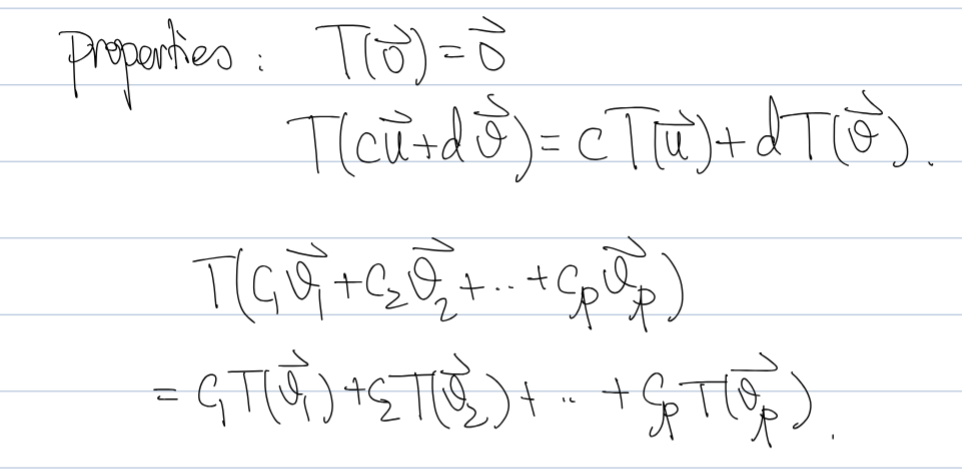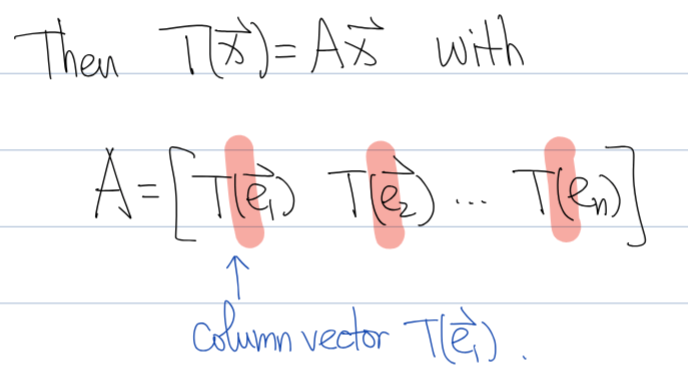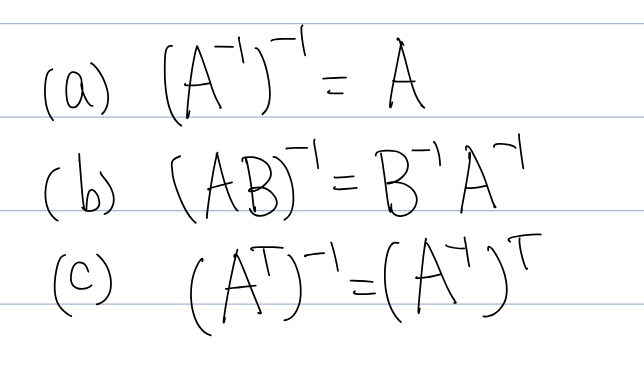MATH 3A Midterm Theorems
1/33
There's no tags or description
Looks like no tags are added yet.
Name | Mastery | Learn | Test | Matching | Spaced |
|---|
No study sessions yet.
34 Terms
Each matrix is row equivalent to ________
one and only one reduced echelon form
Existence and Uniqueness Theorem
Inconsistent (no solution) if there is a row like [ 0 0 0 | b ] because b ≠ 0
Consistent (either one solution or ∞ solutions) otherwise.
One solution: no free variables, all variables are leading
Infinite solutions: at least one free variable
Matrix Equation Ax = b Theorem
If A has a pivot position in every row:
Ax = b has a solution for every b in Rm
Every b in Rm is a linear combination of a1 … an (column vectors)
Columns of A span Rm
Homogeneous Equation Theorem
Homogeneous equation Ax = 0 only has a nontrivial solution if there is at least one free variable
If Ax = b is consistent and let p be one particular solution then…
the set of all solutions is w = p + span (v1 .. vp)
We write w = p + v h where v h is any solution of Ax = 0
A set of vectors is called to be linearly independent if…
x1a1 + x2a2 … xnan = 0 has only the trivial solution
Has no FV
A set of vectors is called to be linearly dependent if…
If x1a1 + x2a2 … xnan = 0 has nontrivial solutions
If at least one of the vectors is a multiple of the other
If there is a zero vector
If there are more vectors than entries in the vector (more columns than rows, means there will be at least one FV)
Summary of trivial vs non trivial
No FV = linearly independent = trivial solutions = no zero vector
At least one FV = linearly dependent = nontrivial solutions = zero vector
A transformation is linear if
T(u+v) = T(u) + T(v)
T(cu) = cT(u)
Properties of linear transformations

Let T: Rn to Rm be a linear transformation. Then…

T: Rn to Rm is said to be onto if…
Each b in Rm is the image of at least one x in Rn
OR or every b in Rm, T(x) = b has at least one solution (consistent)
OR the range/span of T is the whole Rm
OR each row has a pivot
T: Rn to Rm is said to be one-to-one if…
each b in Rm is the image of at most one x in Rn
OR it has at most one solution
OR if each column has a pivot (no free variables)
OR T(x) = has only the trivial solution Ax = 0
OR columns are linearly independent
Let A be the standard matrix of T
T(x) = b => Ax = b has at least one solution for every b
All of these statements are true
Every b in Rn is a linear combination of columns b = x1a1 + x2a2 … xnan
Span {a1, a2 …an} = Rn
Ax = b is consistent
Each row of A has a pivot
Let A be the standard matrix of T
T(x) = b => Ax = b has at most one solution for every b
All of these statements are true
For b = 0, T(x) = Ax = 0 has only trivial solution
0 = x1a1 + x2a2 … xnan has only trivial solution x1 = x2 = … = xn = 0
{a1, a2 …an} is linearly independent
A has no free variables # pivots ≥ column numbers (no cap for free vars)
Determinant Theorem
If ad - bc ≠ 0 then A is invertible
If ad - bc = 0, then A is singular
det(A) = ad - bc
If A is an invertible n x n matrix, then for each b in Rn…
Ax = b has the unique solution x = A-1b
Properties of Inverses

Characterization of Invertible Matrices
**only for the square matrices
From a row reduction perspective
A is invertible
A is row equivalent to the n x n identity matrix
A has n pivot position
Once we know each column has a pivot
The homogenous system Ax = 0 only has trivial solution x = 0
The columns of A are linearly independent
The linear transformation x |—> Ax is one-to-one
Meanwhile, each row has a pivot (consistent)
The equation Ax = b has at least one solution for each b in Rn
The columns of A span Rn
The linear transformation x |—> is onto
From the matrix multiplication perspective
There is a matrix such that CA = I
There is a matrix D such that AD = I
AT is invertible
A linear transformation T: Rn to Rm is said to be invertible if…
There exists an S: Rn to Rm such that SºT(x) = S(T(x)) = x for all x and vice versa. S is the inverse of T
What is the standard matrix of T-1
A-1
A subspace of Rn says H is in Rn if
0 is in H
For each u,v in H, u +v is in H
For each u in H, cu is in H
The column space of a matrix A is…
the span of all column of A
A is m x n A = [a1…an]
n column vectors in Rm
col A = span {a1..an} subspace of Rm
The null space of matrix A is…
the set of solutions to the homogeneous equation Ax = 0
Null space theorem
The null space of an m x n matrix is a subspace of Rn
The basis of a subspace H is…
a linearly independent set in H that spans H
The basis for Col A
The pivot columns of a matrix A
The dimension of H
Denoted by dim H = the number of vectors in any basis for H
Rank of Matrix A
Denoted by rank A = dim col A
# of pivot columns in its reduced echelon form
Rank Theorem
A is m x n
Rank A + dim Nul A = n
#pivots + #free variables = total number of variables
Basis Theorem
If dim H = p, then any p linearly independent vectors of H automatically form a basis of H
If A is n x n then the following is true
A is invertible
col A = Rn
rank A = n
dim Nul A = 0
Nul A = {0}
What are a and b when there is a transformation from Ra to Rb
a = # columns
b = # rows
Remember this
